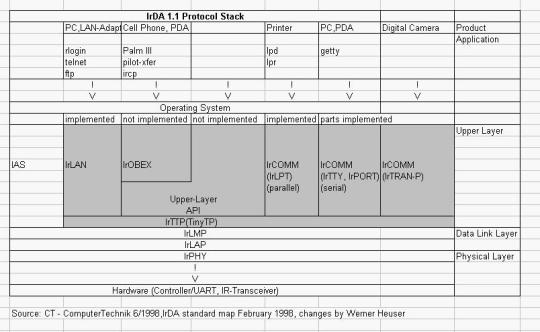5.10. IrDA Protocols
5.10.2. Existing IrDA Protocol Implementations
From Lichen Wang I have taken these remarks:
IrLAP, IrLMP, and TinyTP are pretty stable now. But various individual implementations may still have quirks.
IrCOMM is widely used, but Microsoft vowed to drop it and use IrSocket only.
IrObex, IrMC, IrTran-P, etc. are showing up in various devices. The supports on PC are segmented and sometimes very poor.
New IrDA Protocol Development AIR is pushed mainly by IBM. You get wider angle and longer distance (10M?) but may be at lower data rate. You can also time-multiplex this already slow channel. In my opinion the benefit to the user is very little. AIR hardware and software changes are costly. I think you will have to wait for a long time, if ever, to see any product using AIR.
IrBUS is pushed mainly by Sharp. It is aimed at remote control, IR keyboard, etc., not for data communication. I think if Sharp succeed, you may see IrBUS in set-top boxes, web-tv, etc. If and when these devices reaches a critical mass, some PC may incorporate IrBUS in order to control these devices.
VFIR is the latest. The benefit is higher data rate (16 Mbps). Unlike AIR and IrBUS, the software changes for VFIR are minimum. The changes are mainly in hardware.
In summary, I do not think we need to wait in anticipation of new IrDA protocols. A easy to install and solid implementation of the existing IrDA protocols is the cutting edge!.
